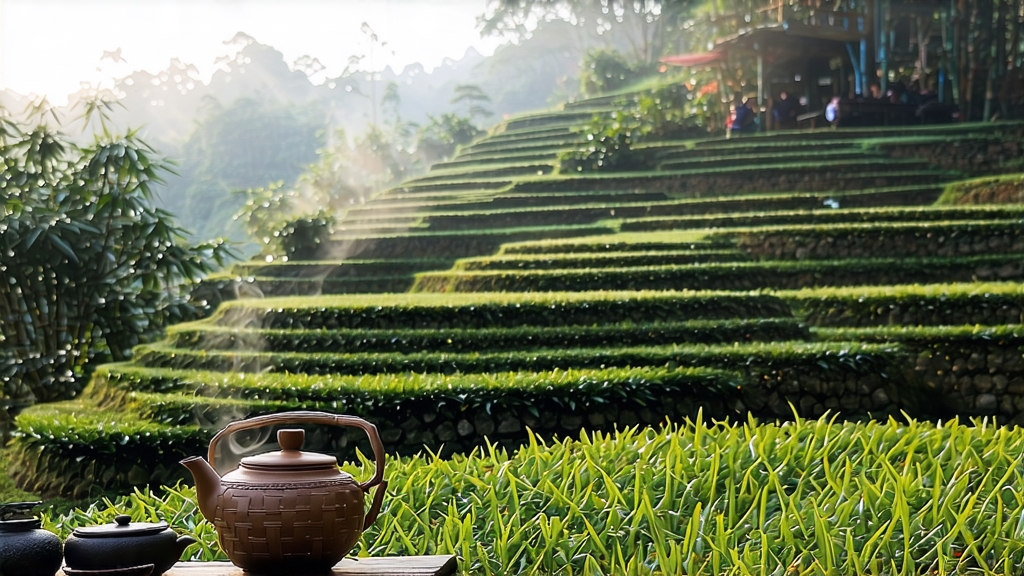
Hidden above the perpetual cloud belt of Mt. Mengding in Sichuan province, a tea once reserved for Tang-dynasty emperors still unfurls its down-covered buds each early April. International drinkers may know Longjing or Pu-erh, yet Meng Ding Huang Ya—literally “Meng Summit Yellow Bud”—remains China’s best-kept yellow secret. This essay invites you to journey through 1,200 years of court chronicles, microclimates, and meticulous craft so you can brew, taste, and share the liquor that poets praised as “the soft gold of the morning sun.”
-
Historical tapestry
The first written record appears in 808 CE when the monk Gan Zhi presented “yellow sprouts from Meng Peak” to Emperor Xianzong. By the Song dynasty the tea was taxed in silver, and Ming Taizu listed it among the eight “tribute teas” that commoners were forbidden to pick under pain of flogging. European travelers tasted it in 1904 when the British consulate in Chengdu shipped 12 chests to the India Office, describing the flavor as “between a first flush Darjeeling and warm croissant.” Political turmoil in the 1930s caused production to cease; the craft was resurrected in 1959 by the state-owned Mengding Tea Farm and quietly returned to world-stage acclaim by winning a Gold Medal at the 1982 Geneva Food Expo. -
Terroir and micro-ecology
Mt. Mengding rises to 1,456 m where the Min River meets the Tibetan Plateau’s wet monsoon. Night temperatures drop 10 °C within hours, forcing the tea bush to condense amino acids. The red-yellow lateritic soil is 5.2–5.8 pH, rich in ionized iron that gives the finished leaf its characteristic ochre rim. Ancient ginkgo and wild osmanthus trees provide partial shade, adding floral lactones to the leaf surface. Because the mountain sits inside a UNESCO cloud-forest reserve, pesticides have been banned since 1998; instead, farmers hang sticky yellow boards and release Trichogramma wasps to control leafhoppers. -
Cultivar and plucking standard
Only the local small-leaf landrace “Mengding #9” is used. On the eve of Qingming, women climb bamboo ladders to pick the “dragon claw” standard: one unopened bud plus the adjacent half-open leaf, 1.8–2.2 cm in length, 0.18–0.22 g in weight. Twenty thousand such shoots yield just 500 g of finished tea, explaining why retail prices rival silver itself. -
The menhuang “sealed yellowing” craft
Yellow tea’s soul lies in an extra step between green tea’s kill-green and rolling. The fresh leaf is first pan-fired at 180 °C for 3 min to destroy 85 % of polyphenol oxidase, then immediately wrapped in steamed cotton cloth and placed inside a bamboo chamber kept at 28 °C and 78 % relative humidity for 48 h. During this menhuang phase chlorophyll degrades to pheophytin, catechins dimerize into theaflavins, and a mellow “chestnut-milky” aroma emerges. The bundle is opened every 12 h to re-oxygenate, a rhythm known as “dreaming and waking.” Finally the leaf is gently charcoal-baked over embers of local cedar wood until moisture falls to 5 %, then rested in lime-lined earthen jars for 30 days to stabilize flavor. -
Grades and nomenclature
Meng Ding Huang Ya is classified into four ascending grades:- Yu Zhen (Jade Needle): 70 % buds, palest infusion, lilac nose.
- Jin Ya (Golden Bud): 50 % buds, balanced sweetness, apricot stone finish.
- Gong Ting (Tribute Court): 30 % buds, deeper yellow, honeyed body.
- Te Gong (Special Tribute): 100 % buds, limited to 80 kg per year, auctioned in Hong Kong.
-
Brewing technique
Water: spring or filtered, 85 °C for Yu Zhen, 90 °C for Te Gong.
Utensil: 150 ml tall glass or Jingdezhen gaiwan to watch the “three ups and three downs” dance of buds.
Ratio: 3 g leaf to 100 ml